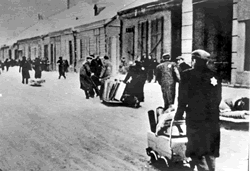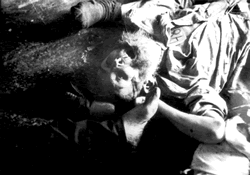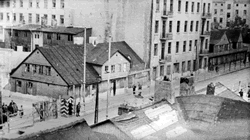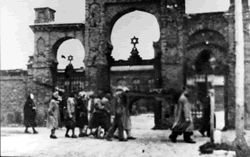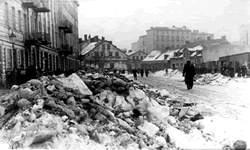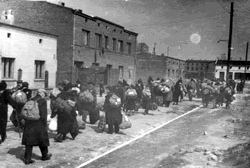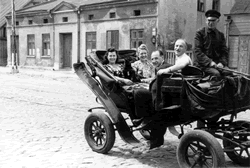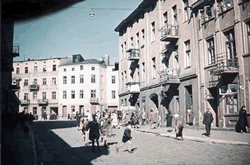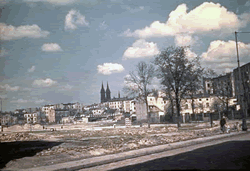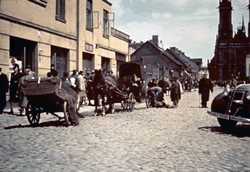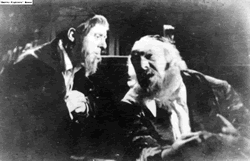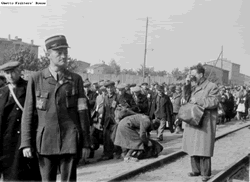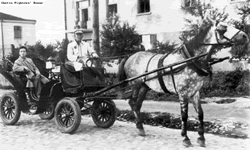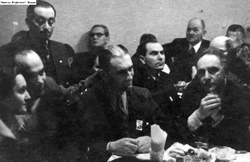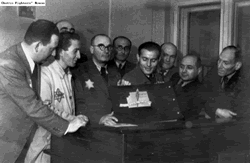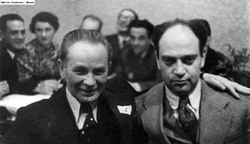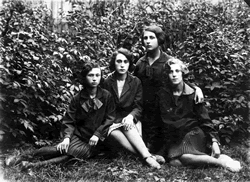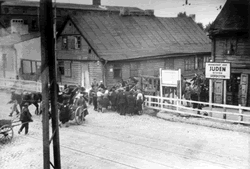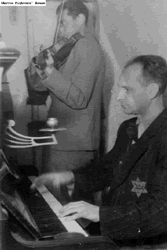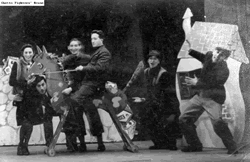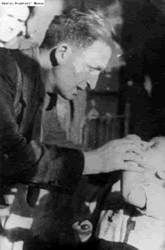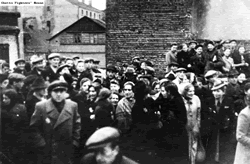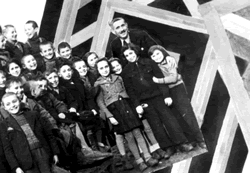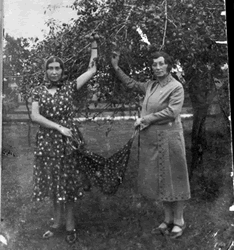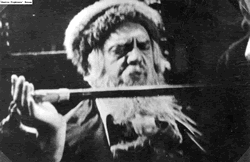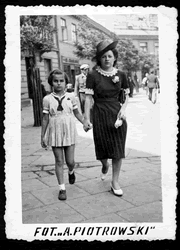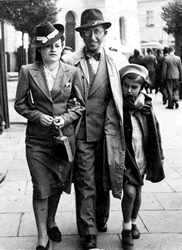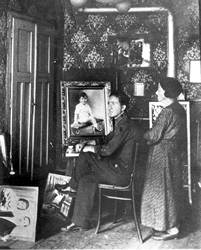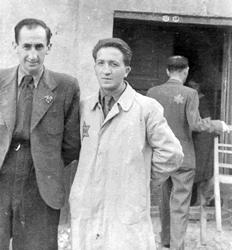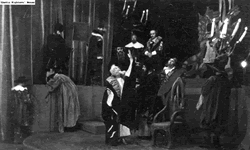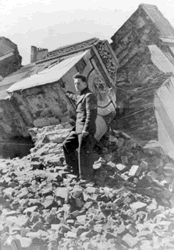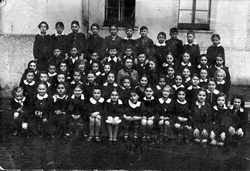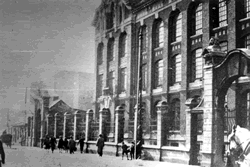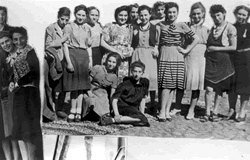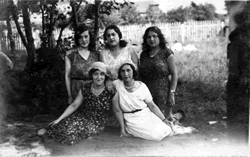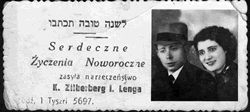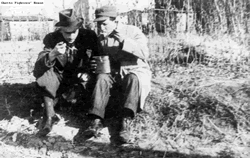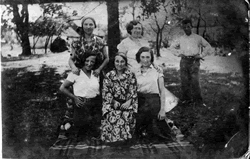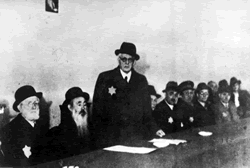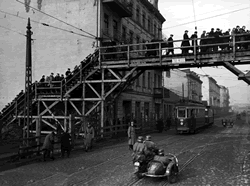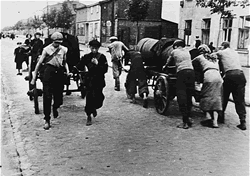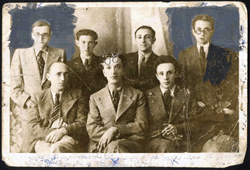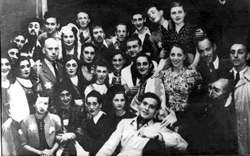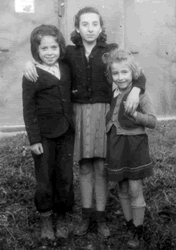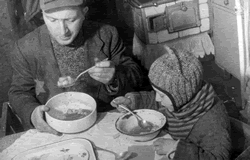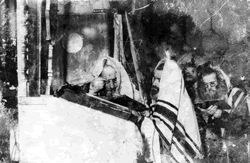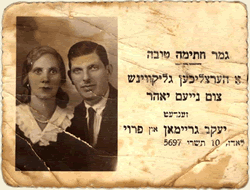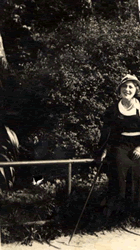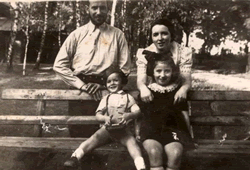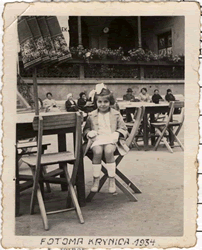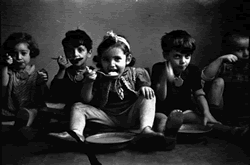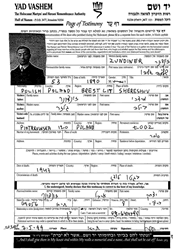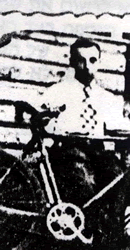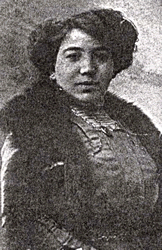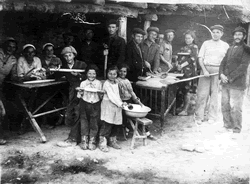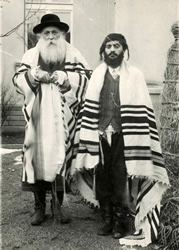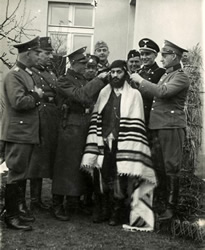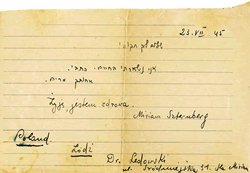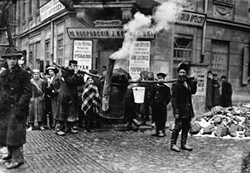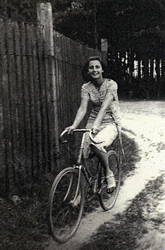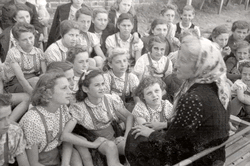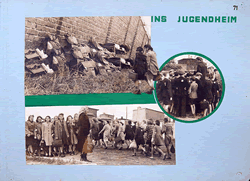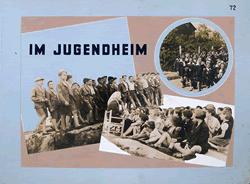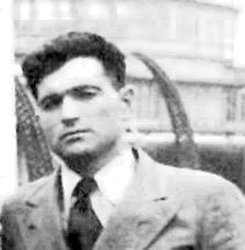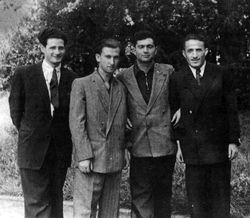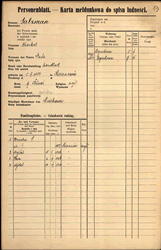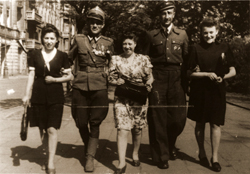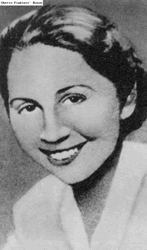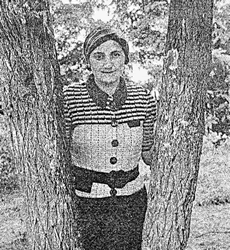|
#lodz-1: Jews transporting their belongings to the ghetto. |
#lodz-2 : Lodz, Poland, The body of an elderly man killed during a deportation (No. 48). |
#lodz-3: Overhead view of a main street in the city and the entrance to the ghetto. |
|
#lodz-4: Lodz, 27/07/1942, The funeral of Moshe Yaakobson in the ghetto. |
#lodz-5: Lodz, Poland, Ruins in the ghetto. |
#lodz-6: Lodz, Jews being deported from the ghetto. |
#lodz-7: Jews from the privileged class. |
#lodz-8: |
#lodz-9: |
#lodz-10: |
#lodz-11: Jewish theater actors in Lodz, in a performance in 1938 |
#lodz-12: The deportation of Jews from the Lodz ghetto. The deportees are standing along the length of railrod tracks. A Jewish ghetto policeman named Smietana, wearing an armband and a yellow badge, accompanies the group. Some of the deportees have a tag attached to the lapel of their clothing, indicating the number of the transport. |
#lodz-13: Traveling in Rumkowski's carriage in the Lodz ghetto. |
#lodz-14: A party in Lodz for actors from the "Habimah" theater of Tel Aviv, who were visiting in the city. Photographed in 1938 |
#lodz-15: The photographer Mendel Grosman presenting an album of the Lodz ghetto to senior officials of the ghetto Judenrat Two of them are Jewish ghetto policemen wearing armbands. Grosman is standing fourth from the right. |
#lodz-16: A party in Lodz before the war. |
#lodz-17: Lodz, Poland, four young Jewish women, 1927. |
#lodz-18: Lodz, Poland, Jews at the entrance to the ghetto during the war. |
#lodz-19: Lodz Ghetto musicians |
#lodz-20: The photographer Mendel Grosman (on the horse) with actors from the play, "Dos Wunder Pferdel" (Yiddish: the Little Wonder - Horse") in the Lodz ghetto. |
#lodz-21: A collection of photographs from the Lodz Ghetto photographed by ghetto photographer Mendel Grossman and his assistant Aryeh Ben Menachem. |
#lodz-22: Mendel Grosman feeding his nephew, Jakow (Jankusz) Freitag, in the Lodz ghetto. |
#lodz-23: Employees of the Department of Kitchens in the Lodz ghetto, waiting to be photographed prior to the issuing of their work permits. In the photo: Alter Schildelkauf (last row, fifth from the left), Mendel Grosman (row nearest the camera, second from the left). Grossman has a yellow badge. |
#lodz-24: Lodz, Poland, A teacher with children. |
#lodz-25: Lodz, Poland, Two women picking fruit from a tree, before the war. |
#lodz-26: Morawski, a Jewish theater actor in Lodz, in a performance in 1938. |
#lodz-27: Lodz, Poland of Yoss Horowicz in ( Polish Army) uniform, 10/10/1931 |
#lodz-28: Lodz, Poland, a photograph of Aodishka Horowitz and her daughter before 1939. |
#lodz-29: Aodishka Horowitz, her husband and their daughter Rita in Lodz, before the war. |
#lodz-30: Lodz, Poland, Mendel Grossman in his study, Prewar. |
#lodz-31: The Lodz ghetto photographer, Mendel Grosman, with Aharon Jakobson, a founder of the Hazit Dor Bnei Midbar |
#lodz-32: A scene from the play, "Uriel da Costa," staged by the Jewish theater of Lodz. Photographed on May 23, 1938. |
#lodz-33: Mendel Grosman on the ruins of the synagogue on Wolborska Street in the Lodz ghetto |
#lodz-34: Lodz, Poland, Class photograph of students and their teachers, before the war |
#lodz-35: Prewar Lodz. |
#lodz-36: A group of young Jewish women in prewar Lodz. |
#lodz-37: |
#lodz-38: |
#lodz-39: In the Lodz ghetto. |
#lodz-40: |
#lodz-41: The Lodz Ghetto Jewish Council. |
#lodz-42: The Bridge on Kirchenplatz Connecting Two Parts of the Lodz Ghetto. |
#lodz-43: Jews at forced labor, transporting excrement down a ghetto street. Lodz ghetto, Poland, wartime. |
#lodz-44: Lodz, Poland, A group of Jewish writers and Journalists, 1938. |
#lodz-45: Lodz, Poland, A group photograph of the ghetto theater players. |
#lodz-46: Lodz 1946 , children who survived. From right to left: Hadassah Sat (Danusia Warszawska) , Aviva Ostra, Bronia Sosnowska-Nagu |
#lodz-47: The photographer Mendel Grossman with his young nephew Yaacov Freitag in the Lodz ghetto, Poland. |
#lodz-48: October 1941 |
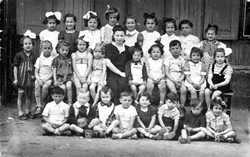 |
||
#lodz-49: |
#lodz-50: Jacob Graiman and wife, September 26, 1936. The inscription : “May you be inscribed for a good year. Our heartfelt wishes for success in honor of the New Year, Jacob Graiman and his wife. Lodz, the 10th of Tishrei 5697”. Jacob and his wife perished during the Holocaust. |
#lodz-51: Mania Weinberg nee Shreiber was born in Krakow, Poland.. She was |
#lodz-52: The Bronstein/ Wienberg family of Lodz perished in the holocaust. |
#lodz-53: Hana Weinberg was born in Lodz, Poland in 1930 to Meir and Mania nee |
#lodz-54: Pola Landaunee Weinberg perished in the Holocaust. |
#lodz-55: Yehiel Weinberg was born in Poland to Abish and Pesa. He was a |
#lodz-56: |
#lodz-57: |
#lodz-58: Zelig Zundiner was born in Lodz, Poland in 1919 to Shlomo and Rivka. He was a yeshiva student. Prior to WWII he lived in Lodz, Poland. During the war he was in Lodz, Poland. Zelig was murdered in the Shoah on the last day before liberation. This information is based on a Page of Testimony (displayed on left) submitted by his brother, a Shoah survivor. |
#lodz-59: Shlomo Zundiner was born in Shereshov, Poland in 1890 to Mordekhai and Bila. He was a merchant. Prior to WWII he lived in Lodz, Poland. Shlomo was murdered in the Shoah. This information is based on a Page of Testimony (displayed on left) submitted by his son. |
#lodz-60:
Liba was murdered in the Shoah. This information is based on a Page of Testimony (displayed on left) submitted by her son, a Shoah survivor. |
#lodz-61: |
#lodz-62: The Holocaust Memorial in Berlin got these photos about ten years ago from IPN in Poland, but there was no date attached to the file. This iconic photograph of uniformed Germans publicly humiliating a Jew was taken in Warta near ?ód? - the Jewish man has been identified as Hersz Laskowski, son of the rabbi Eliasz Laskowski. In 1942, father and son were hanged together. Please contact Adam Kerpel-Fronius if you can help with dating the picture! ( between 1939- 1942) |
#lodz-63: The Holocaust Memorial in Berlin got these photos about ten years ago from IPN in Poland, but there was no date attached to the file. This iconic photograph of uniformed Germans publicly humiliating a Jew was taken in Warta near ?ód? - the Jewish man has been identified as Hersz Laskowski, son of the rabbi Eliasz Laskowski. In 1942, father and son were hanged together. Please contact Adam Kerpel-Fronius if you can help with dating the picture! ( between 1939- 1942) |
#lodz-64: To my sister Tikvah, I survived. Write me. |
#lodz-65: Pre Passover cleaning in Lodz during the first world war |
#lodz-66: Wanda Rein Lodz 1939 |
#lodz-67: Stella Rein (wearing scarf), teacher and principal of the Rumkowski high school in the Lodz ghetto, with her pupils in Marysin (the agricultural area of the ghetto), 1941-1942. |
#lodz-68: Photographs from the children’s home in the Lodz ghetto. |
#lodz-69: Photographs from the children’s home in the Lodz ghetto. |
#lodz-70: Lodz Ghetto 1942. All Jewish children under the age of 10 were taken to be killed. |
#lodz-71: My father, Meir Blecher,1951, Lodz. |
#lodz-72: Poland, Lodz,1951. |
#lodz-73: Jewish Records Indexing - Poland has provided links to this new resource for Lodz, Poland researchers. The Polish State Archives have digitized these cards and placed some of them online this month. |
#lodz-74: |
#lodz-75: From: A. Ben-Ami <dufs44@bezeqint.net> Shalom: Thank you |
#lodz-76: Niuta Tajtelbaum ("Wanda"), Jewish Communist and member of the Polish Armia Ludowa underground in Warsaw (Warszawa). Her name in the underground was Wanda Witwicka. |
#lodz-77: Gitler family |
#lodz-78: Bela Elinger nee Kliger(1907- 2000). |
|
|
Created by Eilat Gordin Levitan
Please share your comments or photos or links for posting on our Guestbook Page here: egl.comments@gmail.com
http://en.wikipedia.org/wiki/%C5%81%C3%B3d%C5%BA
?ód? (Ukrainian and Russian: ?????, Lodz, Yiddish: ?????, Lodzh) is
the third-largest city in Poland. Located in the central part of the
country, it had a population of 742,387 in December 2009. It is the
capital of ?ód? Voivodeship, and is approximately 135 kilometres (84
mi) south-west of Warsaw. The city's coat of arms is an example of
canting: depicting a boat, it alludes to the city's name which
translates literally as "boat".
?ód? first appears in the written record in a 1332 document giving the
village of ?odzia to the bishops of W?oc?awek. In 1423 King W?adys?aw
Jagie??o granted city rights to the village of ?ód?. From then until
the 18th century the town remained a small settlement on a trade route
between Masovia and Silesia. In the 16th century the town had fewer
than 800 inhabitants, mostly working on the nearby grain farms.
With the second partition of Poland in 1793, ?ód? became part of the
Kingdom of Prussia's province of South Prussia, and was known in
German as Lodsch. In 1798 the Prussians nationalised the town, and it
lost its status as a town of the bishops of Kuyavia. In 1806 ?ód?
joined the Napoleonic Duchy of Warsaw and in 1810 it had 190
inhabitants. In 1815 Congress of Vienna treaty it became part of
Congress Poland, a client state of the Russian Empire.
Industrial growth
In the 1815 treaty, it was planned to renew the dilapidated town and
with the 1816 decree by the Czar a number of German immigrants
received territory deeds for them to clear the land and to build
factories and housing. In 1820 Stanis?aw Staszic aided in changing the
small town into a modern industrial centre. The immigrants came to the
Promised Land ( Ziemia obiecana, the city's nickname) from all over
Europe. Mostly they arrived from Southern Germany, Silesia and
Bohemia, but also from countries as far away as Portugal, England,
France and Ireland. The first cotton mill opened in 1825, and 14 years
later the first steam-powered factory in both Poland and Russia
commenced operations. In 1839 the population was 80% Germans and
German schools and churches were established.
A constant influx of workers, businessmen and craftsmen from all over
Europe transformed ?ód? into the main textile production centre of the
Russian Empire. Three groups dominated the city's population and
contributed the most to the city's development: Poles, Germans and
Jews, who started to arrive since 1848. Many of the ?ód? craftspeople
were weavers from Silesia.
In 1850, Russia abolished the customs barrier between Congress Poland
and Russia proper; industry in ?ód? could now develop freely with a
huge Russian market not far away. Soon the city became the
second-largest city of Congress Poland. In 1865 the first railroad
line opened (to Koluszki, branch line of the Warsaw-Vienna Railway),
and soon the city had rail links with Warsaw and Bia?ystok.
One of the most important industrialists of ?ód? was Karl Wilhelm
Scheibler.[1] In 1852 he came to ?ód? and with Julius Schwarz together
started buying property and building several factories. Scheibler
later bought out Schwarz's share and thus became sole owner of a large
business. After he died in 1881 his widow and other members of the
family decided to pay homage to his memories by erecting a chapel,
intended as a mausoleum with family crypt, in the Lutheran part of the
?ód? cemetery in ulica Ogrodowa (later known as The Old Cemetery).
In the 1823–1873, the city's population doubled every ten years. The
years 1870–1890 marked the period of most intense industrial
development in the city's history. Many of the industrialists were
Jewish. ?ód? soon became a major centre of the socialist movement. In
1892 a huge strike paralysed most of the factories.
By 1897, the share of the German population had dropped from 80 to
40%.According to Russian census of 1897, out of the total population
of 315,000, Jews constituted 99,000 (around 31% percent)
During the 1905 Revolution, in what became known as the June Days or
?ód? insurrection, Tsarist police killed more than 300 workers.
Despite the air of impending crisis preceding World War I, the city
grew constantly until 1914. By that year it had become one of the most
densely-populated industrial cities in the world—13,280 inhabitants
per square kilometre (34,400 /sq mi)
A major battle was fought near the city in late 1914, and as a result
the city came under German occupation after 6 December but with Polish
independence restored in November 1918 the local population liberated
the city and disarmed the German troops. In the aftermath of World War
I, ?ód? lost approximately 40% of its inhabitants, mostly owing to
draft, diseases and because a huge part of the German population was
forced to move to Germany.
In 1922, ?ód? became the capital of the ?ód? Voivodeship, but the
period of rapid growth had ceased. The Great Depression of the 1930s
and the Customs War with Germany closed western markets to Polish
textiles while the Bolshevik Revolution (1917) and the Civil War in
Russia (1918–1922) put an end to the most profitable trade with the
East. The city became a scene of a series of huge workers' protests
and riots in the interbellum. On 13 September 1925 a new airport,
Lublinek Airport, started operations near the city of ?ód?. In the
interwar years ?ód? continued to be a diverse city, with the 1931
Polish census showing that the total population of 604,470 included
315,622 (52.21%) Poles, 202,497 (33.49%) Jews and 86,351 (14.28%)
Germans (determination based on the declaration of language used).
Also read Battle of ?ód? (1939)
During the Invasion of Poland the Polish forces of the ?ód? Army of
General Juliusz Rómmel defended ?ód? against initial German attacks.
However, the Wehrmacht captured the city on 8 September. Despite plans
for the city to become a Polish exclave, attached to the General
Government, the Nazi hierarchy respected the wishes of the local
governor of Reichsgau Wartheland, Arthur Greiser, and of many of the
ethnic Germans living in the city, and annexed it to the Reich in
November 1939. The city received the new name of Litzmannstadt after
the German general Karl Litzmann, who captured the city during World
War I. Nevertheless, many ?ód? Germans refused to sign Volksliste and
become Volksdeutsche, instead being deported to the General
Government.
Poniatowski's Park
Soon the Nazi authorities set up the ?ód? Ghetto in the city and
populated it with more than 200,000 Jews from the ?ód? area.[4] As
Jews were deported from Litzmannstadt for "resettlement" others were
brought in. Due to the value of the goods that the ghetto population
produced for the German military and various civilian contractors it
was the last major ghetto to be "liquidated" (destroyed);
approximately 900 people survived the liquidation of the ghetto in
August 1944. Several concentration camps and death camps arose in the
city's vicinity for the non-Jewish inhabitants of the regions, among
them the infamous Radogoszcz prison and several minor camps for the
Romani people and for Polish children.
By the end of World War II, ?ód? had lost approximately 420,000 of its
pre-war inhabitants: 300,000 Polish Jews and approximately 120,000
other Poles. In their place were thousands of new German residents,
many of whom were Volksdeutsch who had been repatriated from Russia
during the time of Hitler's alliance with the Soviet Union. In January
1945 most of the German population fled the city for fear of the Red
Army. The city also suffered tremendous losses due to the German
policy of requisition of all factories and machines and transporting
them to Germany. Thus despite relatively small losses due to aerial
bombardment and the fighting, ?ód? had lost most of its
infrastructure.
The Soviet Red Army entered the city on 18 January 1945. According to
Marshal Katukov, whose forces participated in the operation, the
Germans retreated so suddenly that they had no time to evacuate or
destroy the ?ód? factories, as they did in other cities.[ In time,
?ód? became part of the People's Republic of Poland.
Sculpture of Artur Rubinstein on Piotrkowska Street, in ?ód?, Poland,
where Rubinstein once lived.
Prior to World War II, the Jewish population of ?ód? numbered about
233,000, accounting for one-third of the city’s population. The
community was wiped out in the Holocaust
t the end of World War II, ?ód? had fewer than 300,000 inhabitants.
However the number began to grow as refugees from Warsaw and
territories annexed by the Soviet Union immigrated. Until 1948 the
city served as a de facto capital of Poland, since events during and
after the Warsaw uprising had thoroughly destroyed Warsaw, and most of
the government and country administration resided in ?ód?. Some[who?]
planned moving the capital there permanently, however this idea did
not gain popular support and in 1948 the reconstruction of Warsaw
began. Under the Polish Communist regime many of the industrialist
families lost their wealth when the authorities nationalised private
companies. Once again the city became a major centre of industry. In
mid-1981 ?ód? became famous for its massive, 50,000 hunger
demonstration of local mothers and their children (see: Summer 1981
hunger demonstrations in Poland).
After the period of economic transition during the 1990s, most
enterprises were again privatised. In 2002 the city came to national
attention due to the "Skin Hunters" scandal: doctors and paramedics in
one of the city's hospitals were caught murdering patients and selling
their details to funeral homes for them to contact the relatives.[7]
Four men have been convicted but others are still under investigation.
A film was made of the events in 2003.[8]
Historical population
Fountain on Jan Henryk D?browski Square
Year Population
1793 190
1806 767
1830 4,300
1850 15,800
1880 77,600
1905 343,900
1925 538,600
1990 850,000
2003 781,900
2007 753,192
2009 742,387
?ód? in literature and cinema
Three major novels depict the development of industrial ?ód?.
W?adys?aw Reymont's Ziemia Obiecana (The Promised Land) (1898), Joseph
Roth's Hotel Savoy (1924) and Israel Joshua Singer's Di Brider
Ashkenazi (The Brothers Ashkenazi) (1937). Roth's novel depicts the
city on the eve of a workers' riot in 1919. Reymont's novel was made
into a film by Andrzej Wajda in 1975: see The Promised Land. In the
1990 film Europa Europa, Solomon Perel's family flees pre-WWII Berlin
and settles in ?ód?. Scenes of David Lynch's 2006 film Inland Empire
were shot in ?ód?. Sections of Harry Turtledove's Worldwar alternate
history series take place in ?ód?.
http://en.wikipedia.org/wiki/%C5%81%C3%B3d%C5%BA
http://www.lodz-israel.co.il/eng-index.html
The Association of Lodz Jews in Israel is a non-profit organization that had been registered in Israel at 24 June 1996, and whose Registration Number is 58-028545-0.
In reality, the Organization began operating shortly after the end of WWII. There are many active members in the Organization, survivors and second and third generation children of Holocaust survivors, whose activity in and dedication to the Organization ensures that the Jewish community of Lodz shall never be forgotten, and its legacy will be passed-on to future generations. This Website is part of the commemoration efforts.
The activity of the Organization is carried out entirely by volunteers and is funded by membership fees and donations. The Association is not supported by any formal body or institution.
In the Gallery you will find numerous photos, mostly from the Ghetto and from the commemoration activities today. The photos were provided by the courtesy of the State Archive in Lodz, Poland, to which all the rights are reserved. No copying or any given use of the photos is permitted without the consent of the State Archive.
https://sztetl.org.pl/en/oral-history/183519-estelle-rozinski?is_city=1&city_number=285
